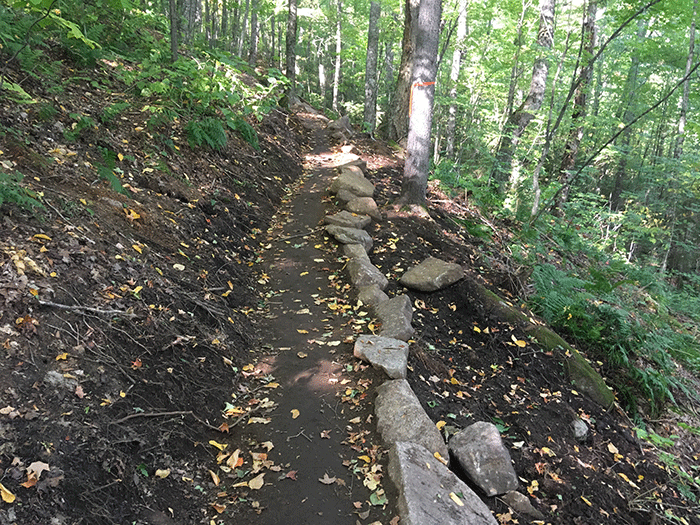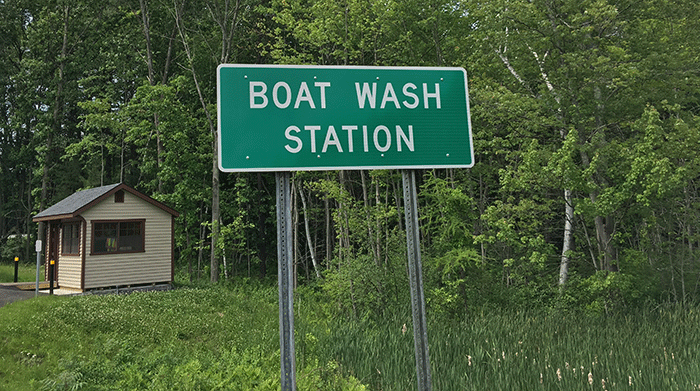Protect the Adirondacks advocates for stronger environmental protections for the Adirondack Park. Protect the Adirondacks is currently involved in a number of advocacy efforts to change public policy and reform management of the Forest Preserve and Adirondack Park and pass legislation to strengthen New York’s environmental laws.
Protect the Adirondacks sees advocacy campaigns as a way to educate the public, Adirondack and state leaders, and key policymakers about major problems facing the Adirondack Park and their possible solutions. Successful advocacy efforts not only raise public awareness about the extraordinary natural resources of the Adirondacks and frame these problems or challenges, but provide workable solutions and point the way forward.
Over the next two years, Protect the Adirondacks is working on a number of advocacy campaigns to resolve longstanding environmental problems and challenges that have beset the Adirondack Park.
Sustainable trails and new management for the High Peaks Wilderness area: By the metric of public use, the High Peaks Wilderness is a major success. The current dismal state of many of the trails does not seem to be a major deterrent. For many people hiking a mountain like a High Peak is no sure thing and is, and should be, a challenge. There are plenty of highly used and popular smaller mountains that provide stunning views, but the allure of hiking a High Peak is immense. For many the view from a High Peak summit and one’s sense of personal accomplishment, however measured, erases their slog over long sections of crappy trails. We need to change this equation so that people can continue to enjoy the High Peaks, push themselves to hike big mountains, create lifelong memories with friends and family, and do all this while hiking over beautiful and sustainable trails. The hiking trails throughout the High Peaks and associated Wilderness areas are in disrepair. They need massive public and private investment to build a new network of sustainable trails. Read more about the need for sustainable trails in the High Peaks Wilderness here, here and here. Protect the Adirondacks has campaigned successfully for greater resources to be invested in rebuilding the trails of the High Peaks Wilderness area and will continue to press for even greater investments.

This is a section of a new sustainable side slope trail currently under construction in the High Peaks Wilderness Area. This trail is specially designed to withstand the heavy recreational use on a popular High Peaks mountain as well as the demanding weather conditions. This trail also upholds the Wilderness management ethos of the area. These types of trails are expensive and labor intensive to build, but will provide better long-term stewardship of the natural resources of the area and a much better public hiking experience.
Reform of the Adirondack Park Agency (APA): The Adirondack Park Agency is broken and Governor Andrew Cuomo broke it. Protect the Adirondacks is advocating for new APA Board members who have experience in environmental law, regional planning and science. The current APA Board of dominated by local government officials and private businesses leaders. The APA Board needs a greater representation of people with a broad range of professional experiences as well as people who will act independently based facts and analysis.
Protect the Adirondacks is also advocating for new legislation to require conservation design for large-scale subdivisions in the Adirondack Park. Conservation design for major subdivisions will serve to preserve the ecological integrity, wildlife and open space in the Adirondack Park. This legislation will strengthen the Adirondack Park Land Use and Development Plan, originally adopted as part of the Adirondack Park Agency Act in 1973, by incorporating modern conservation design principles to curtail widely scattered exurban development, or “rural sprawl” in the Adirondack Park. Conservation science has advanced to the point of recognizing that the spatial pattern of development is fully as ecologically important as its density. Widely scattered exurban development, or “rural sprawl,” impairs ecosystem function, decreases biotic integrity, alters species behavior and composition, increases human-wildlife conflicts, undermines the open space character of the Park, and threatens its healthy timber industry.
Mandatory boat control program to protect Adirondack waters from invasive species: Infestation with an aquatic invasive species (AIS) is one of the major threats facing the ecological health and economy of the Adirondack Park. AIS can rapidly change the ecology of a lake, wetland, stream or river as well as significantly impair and diminish recreational enjoyment. The key vector for spreading AIS is motorboats.
Across the Adirondack Park there are many lakes and ponds that remain uninfested and free of AIS. This is something that highlights the special nature of the Adirondack Park. Prevention is a more successful long-term strategy than direct management when dealing with an invasive species because it’s very difficult to eradicate AIS once established in a water body. It’s far cheaper to focus efforts on interdiction and prevention than direct management. It’s also much better for the ecological health of a water body to prevent an AIS infestation, rather than try and remove AIS once established.
Across the Adirondacks, the Adirondack Watershed Institute has been working to build a successful stewardship program to inspect boats for AIS and inform boat owners of any problems they find. This is a voluntary public education effort, which Protect the Adirondacks believes should be made mandatory in the Adirondacks. Protect the Adirondacks is advocating for a mandatory boat control program for the Adirondack Park to protect the extraordinary lakes, ponds, and rivers of the Adirondacks.
Conversion of the 55 mile railroad from Saratoga Springs to North Creek to a public recreation trail: In 2017 and 2018, Protect the Adirondacks campaigned to stop long-term storage of used, out-of-service oil tankers on remote rail lines in the central Adirondacks. The railroad company that spearheaded this efforts planned to store 2000-3000 used oil tankers on the 20 mile Sanford Lake Railway between North Creek and the Tahawus Mine in Newcomb. Protect the Adirondacks produced a video in opposition in partnerships with local governments and publicized problems with storage plans. Much of this railway passes through the Forest Preserve. In 2018, state agencies intervened after the Governor announced his opposition to the storage plans. Once the oil tankers were removed, the rail line became dormant. The state is now pursuing efforts at the federal level to declare this unused track “abandoned.” Once abandoned under the federal law the rail corridor right-of-way will revert to the private landowners, the largest being the State of New York for the Forest Preserve. Protect the Adirondacks supports the state’s position.
The 20-mile Sanford Lake Railway from North Creek to the Tahawus Mine is connected to the 55-mile-long railway that runs south from North Creek to Saratoga Springs. Unlike the rail line to the north, this rail corridor is owned by Warren County and the Town of Corinth. These municipalities are trying to lease this line, but there are no takers. The best option is to convert the rail line to a public recreation trail. If the 55-mile-long rail trail, which runs through dozens of small communities, and mostly runs alongside the Hudson River, was built it would be one of the best public trail systems in New York.
New land protection to expand the Forest Preserve and conservation easement areas: Protect the Adirondacks is advocating for new purchases of lands for the public Forest Preserve and purchases of new conservation easements. We advocate for funding each year in the NYS Environmental Protection Fund for land protection. There are tremendous opportunties with tracts such as Follensby Pond, the 36,000-acre Whitney Park tract, and new conservation easement opportunities in the northwest Adirondacks, among other places.
New programs to reduce road salt pollution in the Adirondacks: The Adirondacks enjoys many lakes with high water quality, but we also have many lakes with high levels of chloride and sodium, the two main ingredients of salt pollution. Lakes in the Adirondack region have naturally low concentrations of both chloride and sodium. Widespread use of road salt (primarily sodium chloride) over the last several decades has significantly increased the concentration of chloride and sodium in the environment. Many lakes in the Adirondacks now contain anywhere from 10 to 170 times the background concentration of chloride. Adirondack roads receive approximately 208,000 metric tons of road deicers each year, with an annual average of 23 tons of salt applied to each lane kilometer of state roads.
The issue of reducing or eliminating road salt pollution is a challenging one for state and local officials. Winter is six months long in the Adirondacks and many people depend on clear roads for commuting long distances or for winter tourism. The tasks of changing practices and finding alternatives that lessen road salt pollution remains a key challenge for many across the Adirondack Park. Protect the Adirondacks, and many others, are advocating for changes in public roads management policy to use less road salt and transition away from ecologically damaging road salt use.
Reform of NYS septic system laws: No state in the country so poorly regulates onsite wastewater treatment systems (OWTS), commonly known as septic systems, as New York. The State of New York has long lagged far behind the rest of the U.S. in management of septic systems. Many Adirondack lakes see shoulder to shoulder development along their lakeshores and while buildings are often expanded septic systems are usually not upgraded. Faulty septic systems are leading source of nutrient loading and pollution in Adirondack lakes. In New York regulation of septic system occurs when a system is constructed but there is no mechanism to assess the viability of old systems that have been in use for years. Protect the Adirondacks is advocating for a reform of New York State laws to require a septic system inspection at the time of property transfer to ensure that the system is adequate and functional. A system should also be upgraded when a building is expanded.
If you value a strong advocate that is pushing to strengthen protections for the Adirondack Park, you should join with Protect the Adirondacks as a member today! Click here to sign up.


